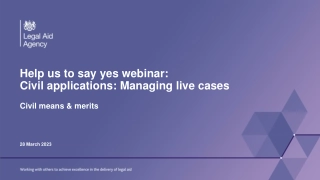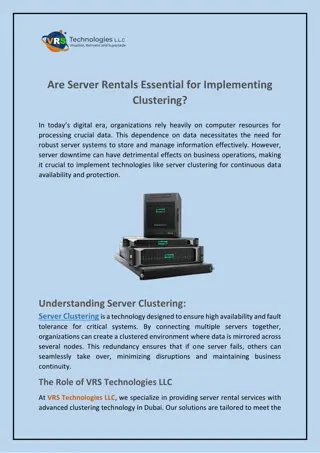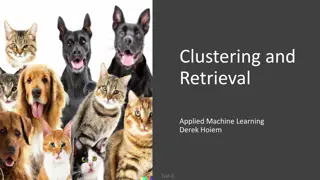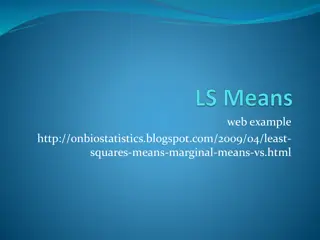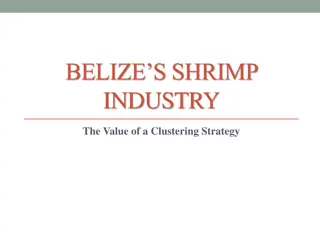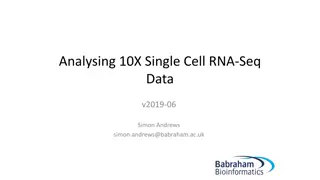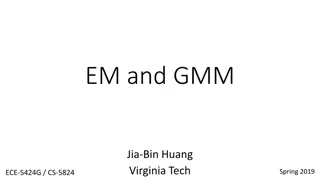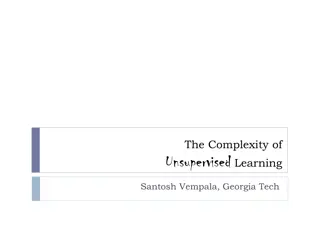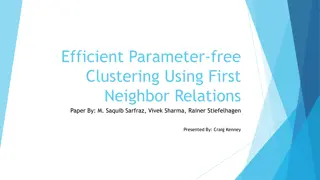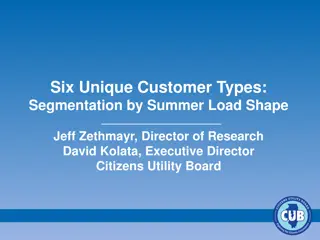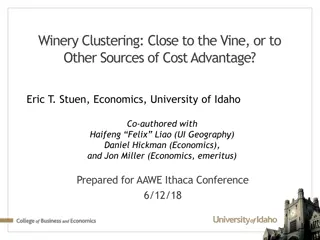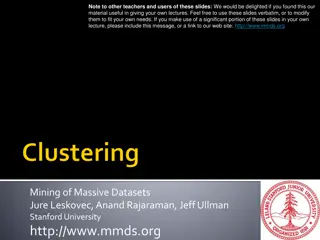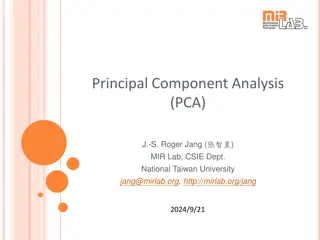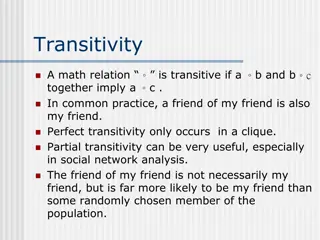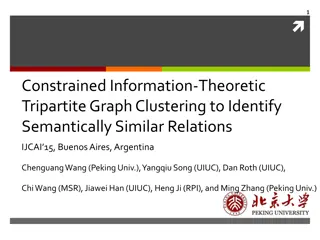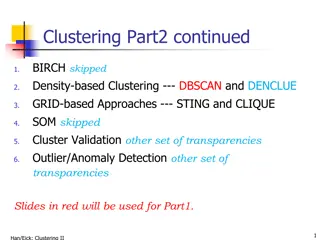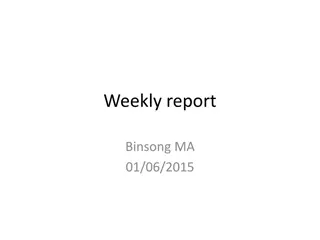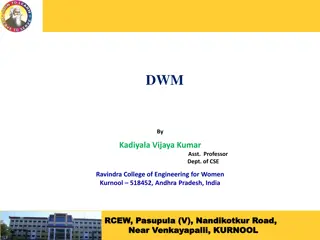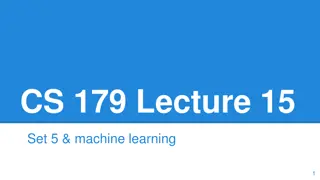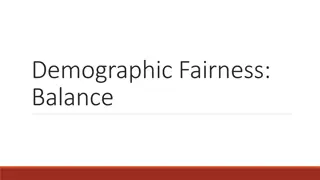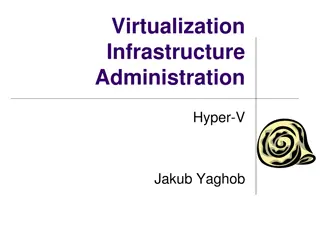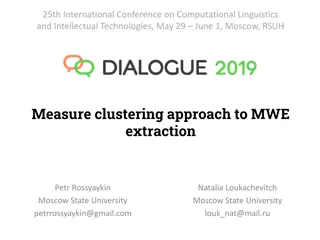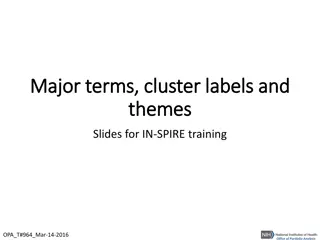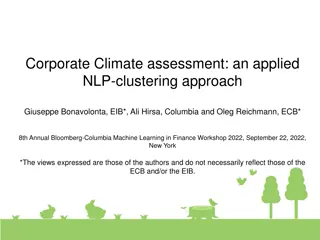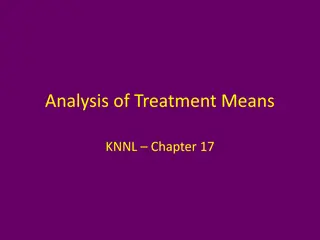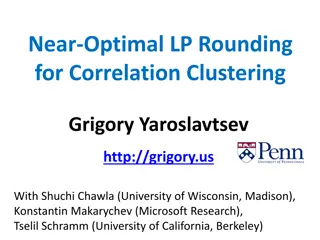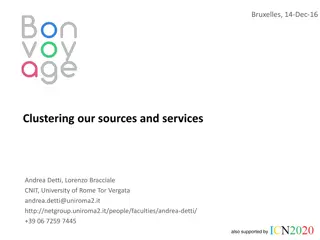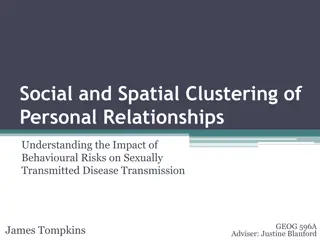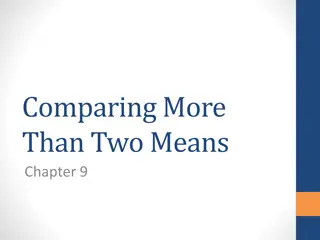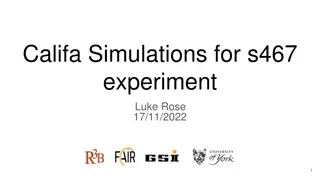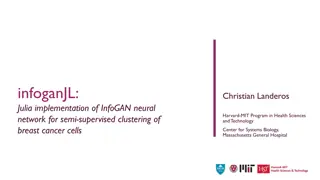Civil Applications: Managing Live Cases Webinar Insights
Gain valuable insights on managing live civil cases through the "Help Us to Say Yes" webinar focusing on civil applications, means re-assessments, merits, and more. Learn about processes such as means re-assessment, amending certificates, means representations, and applying for prior authority. Disc
0 views • 41 slides
Understanding Neural Networks: Models and Approaches in AI
Neural networks play a crucial role in AI with rule-based and machine learning approaches. Rule-based learning involves feeding data and rules to the model for predictions, while machine learning allows the machine to design algorithms based on input data and answers. Common AI models include Regres
11 views • 17 slides
Are Server Rentals Essential for Implementing Clustering?
Discover why renting servers is important for clustering with VRS Technologies LLC's helpful PDF. Learn how to make your IT setup better. For Server Rental Dubai solutions, Contact us at 0555182748.
13 views • 2 slides
Understanding Clustering Algorithms: K-means and Hierarchical Clustering
Explore the concepts of clustering and retrieval in machine learning, focusing on K-means and Hierarchical Clustering algorithms. Learn how clustering assigns labels to data points based on similarities, facilitates data organization without labels, and enables trend discovery and predictions throug
1 views • 48 slides
Bioinformatics for Genomics Lecture Series 2022 Overview
Delve into the Genetics and Genome Evolution (GGE) Bioinformatics for Genomics Lecture Series 2022 presented by Sven Bergmann. Explore topics like RNA-seq, differential expression analysis, clustering, gene expression data analysis, epigenetic data analysis, integrative analysis, CHIP-seq, HiC data,
0 views • 36 slides
Understanding Means and LS Means Calculation in Statistics
Explanation of how means and least squares means (LS Means) are calculated in statistics. Describes the process of calculating means for different treatments and centers, as well as deriving LS Means through an iterative process, including handling empty cells.
1 views • 11 slides
Enhancing Belize's Shrimp Industry Through Clustering Strategies
Belize's shrimp industry is a vital part of its economy, facing challenges in scaling production for exports. Emphasizing quality and identifying competitive advantages are key, along with capitalizing on niche markets and seeking certification. Clustering strategies can help firms collaborate, shar
0 views • 6 slides
Understanding 10X Single-Cell RNA-Seq Data Analysis
Explore the intricacies of analyzing 10X Single-Cell RNA-Seq data, from how the technology works to using tools like CellRanger, Loupe Cell Browser, and Seurat in R. Learn about the process of generating barcode counts, mapping, filtering, quality control, and quantitation of libraries. Dive into di
0 views • 34 slides
Data Science Course Updates and Events Overview
Stay informed with the latest updates and events from the ECE-5424G/CS-5824 course at Virginia Tech. Learn about topics such as EM and GMM, administrative deadlines, distinguished lectures, K-means algorithm, and hierarchical clustering. Mark your calendar for key dates like final project discussion
0 views • 51 slides
Analyzing Shot Location Trends in the NBA
Examining shot location trends in the NBA since 1996, this study delves into the impact on offensive strategies. Utilizing shot charts data and visualizations, the analysis uncovers shifts in shooting patterns, correlations, and evolving efficiency. Techniques like K-Means Clustering are employed to
0 views • 12 slides
Text Analytics and Machine Learning System Overview
The course covers a range of topics including clustering, text summarization, named entity recognition, sentiment analysis, and recommender systems. The system architecture involves Kibana logs, user recommendations, storage, preprocessing, and various modules for processing text data. The clusterin
0 views • 54 slides
Unsupervised Learning: Complexity and Challenges
Explore the complexities and challenges of unsupervised learning, diving into approaches like clustering and model fitting. Discover meta-algorithms like PCA, k-means, and EM, and delve into mixture models, independent component analysis, and more. Uncover the excitement of machine learning for the
0 views • 71 slides
Efficient Parameter-free Clustering Using First Neighbor Relations
Clustering is a fundamental pre-Deep Learning Machine Learning method for grouping similar data points. This paper introduces an innovative parameter-free clustering algorithm that eliminates the need for human-assigned parameters, such as the target number of clusters (K). By leveraging first neigh
0 views • 22 slides
Customer Segmentation and Usage Patterns Analysis
This research delves into segmenting customers based on summer load shapes and matching usage patterns to demographic profiles using census data. It analyzes daily interval volume readings for residential customers, identifies load shape clusters, and explores their distribution across different are
0 views • 15 slides
Utilizing Replicate Estimate (Repest) for PISA and PIAAC Data Analysis in Stata
Explore how to use the Stata routine Repest for complex survey designs, accommodating final weights, replicate weights, and imputed variables in PISA and PIAAC data analysis. Learn to install and apply Repest to compute means of variables while accounting for sampling variance, clustering, and strat
0 views • 28 slides
Machine Learning Techniques: K-Nearest Neighbour, K-fold Cross Validation, and K-Means Clustering
This lecture covers important machine learning techniques such as K-Nearest Neighbour, K-fold Cross Validation, and K-Means Clustering. It delves into the concepts of Nearest Neighbour method, distance measures, similarity measures, dataset classification using the Iris dataset, and practical applic
1 views • 14 slides
Understanding Winery Clustering in Washington State: Factors and Implications
Explore the phenomenon of winery clustering in Washington State, examining factors such as natural advantages, collective reputation, and demand-side drivers. Discover why wineries in the region tend to locate close to each other and the impact on cost advantage and industry dynamics.
0 views • 18 slides
Understanding Data Structures in High-Dimensional Space
Explore the concept of clustering data points in high-dimensional spaces with distance measures like Euclidean, Cosine, Jaccard, and edit distance. Discover the challenges of clustering in dimensions beyond 2 and the importance of similarity in grouping objects. Dive into applications such as catalo
0 views • 55 slides
Understanding Principal Component Analysis (PCA) in Data Analysis
Introduction to Principal Component Analysis (PCA) by J.-S. Roger Jang from MIR Lab, CSIE Dept., National Taiwan University. PCA is a method for reducing dataset dimensionality while preserving spatial characteristics. It has applications in line/plane fitting, face recognition, and machine learning
0 views • 23 slides
Understanding K-means Clustering for Image Segmentation
Dive into the world of K-means clustering for pixel-wise image segmentation in the RGB color space. Learn the steps involved, from making copies of the original image to initializing cluster centers and finding the closest cluster for each pixel based on color distances. Explore different seeding me
0 views • 21 slides
Understanding Transitivity and Clustering Coefficient in Social Networks
Transitivity in math relations signifies a chain of connectedness where the friend of a friend might likely be one's friend, particularly in social network analysis. The clustering coefficient measures the likelihood of interconnected nodes and their relationships in a network, highlighting the stru
0 views • 8 slides
Semantically Similar Relation Clustering with Tripartite Graph
This research discusses a Constrained Information-Theoretic Tripartite Graph Clustering approach to identify semantically similar relations. Utilizing must-link and cannot-link constraints, the model clusters relations for applications in knowledge base completion, information extraction, and knowle
0 views • 14 slides
Density-Based Clustering Methods Overview
Density-based clustering methods focus on clustering based on density criteria to discover clusters of arbitrary shape while handling noise efficiently. Major features include the ability to work with one scan, require density estimation parameters, and handle clusters of any shape. Notable studies
0 views • 35 slides
Analysis of Particle Clustering and Reconstruction Methods in Binsong, MA
This weekly report delves into the detailed examination of dEdx in PID, charged particle clustering in the Lcal region, neutral particle reconstruction, and methods involving the Clupatra Track collection and TPCTrackerHits collection. The report showcases the processes, methods, and results related
0 views • 7 slides
Understanding Clustering Methods for Data Analysis
Clustering methods play a crucial role in data analysis by grouping data points based on similarities. The quality of clustering results depends on similarity measures, implementation, and the method's ability to uncover patterns. Distance functions, cluster quality evaluation, and different approac
0 views • 8 slides
Understanding Text Vectorization and Clustering in Machine Learning
Explore the process of representing text as numerical vectors using approaches like Bag of Words and Latent Semantic Analysis for quantifying text similarity. Dive into clustering methods like k-means clustering and stream clustering to group data points based on similarity patterns. Learn about app
0 views • 25 slides
Achieving Demographic Fairness in Clustering: Balancing Impact and Equality
This content discusses the importance of demographic fairness and balance in clustering algorithms, drawing inspiration from legal cases like Griggs vs. Duke Power Co. The focus is on mitigating disparate impact and ensuring proportional representation of protected groups in clustering processes. Th
0 views • 36 slides
Building Our Own Virtualized Infrastructure with Hyper-V
Learn how to set up a virtualized infrastructure using Hyper-V, including deploying Windows Server 2019, configuring Active Directory, setting up Failover Clustering, and managing Hyper-V Core servers. The guide covers network setup, domain controller promotion, clustering setups, iSCSI configuratio
0 views • 10 slides
Unsupervised Multiword Expression Extraction Using Measure Clustering Approach
Goal of this study is to develop an unsupervised method for extracting multiword expressions (MWEs) like idioms, terms, and proper names of different semantic types. The research focuses on properties of MWEs, data analysis, statistical measures, and clustering results to supplement lexical resource
0 views • 44 slides
Understanding Clustering Algorithms in Data Science
This content discusses clustering algorithms such as K-Means, K-Medoids, and Hierarchical Clustering. It explains the concepts, methods, and applications of partitioning and clustering objects in a dataset for data analysis. The text covers techniques like PAM (Partitioning Around Medoids) and AGNES
0 views • 74 slides
Understanding Major Terms, Cluster Labels, and Themes in IN-SPIRE Training
Major terms in IN-SPIRE are keywords used for clustering documents, while cluster labels in Galaxy view represent the most important terms associated with a point. Themes, calculated by clustering keywords, provide a higher-level description of data. PNNL techniques like RAKE and CAST help extract a
0 views • 4 slides
Understanding Corporate Climate Assessment Using NLP Clustering
This work explores a novel approach in corporate climate assessment through applied NLP clustering, highlighting the relationship between climate risk and financial implications. The use of advanced techniques like BERT embedding for topic representation and clustering in corporate reports is discus
0 views • 33 slides
Statistical Analysis of Treatment Means in Experimental Studies
The content discusses various statistical methods to analyze treatment means in experimental studies, including KNNL models, main effects plots, inference for individual treatment means, comparing two treatment means, and contrasts among treatment means. It covers topics such as parameter estimation
0 views • 25 slides
Correlation Clustering: Near-Optimal LP Rounding and Approximation Algorithms
Explore correlation clustering, a powerful clustering method using qualitative similarities. Learn about LP rounding techniques, approximation algorithms, NP-hardness, and practical applications like document deduplication. Discover insights from leading researchers and tutorials on theory and pract
0 views • 27 slides
Clustering Sources and Services for ITS Data Sharing in Brussels
Andrea Detti and Lorenzo Bracciale from CNIT, University of Rome Tor Vergata, discuss clustering projects for Intelligent Transportation System (ITS) data and services in Brussels. The presentation covers the problem, solutions, consumer and producer guidance, and contact information for further inq
0 views • 13 slides
Exploring Avatar Path Clustering in Networked Virtual Environments
Explore the concept of Avatar Path Clustering in Networked Virtual Environments where users with similar behaviors lead to comparable avatar paths. This study aims to group similar paths and identify representative paths, essential in analyzing user interactions in virtual worlds. Discover related w
0 views • 31 slides
Understanding Social and Spatial Clustering of Personal Relationships in STI Transmission
Exploring the impact of behavioral risks on the transmission of sexually transmitted infections (STIs) through social and spatial clustering of personal relationships. The rise in STIs globally and in Canada is highlighted, emphasizing transmission methods, efficiency rates, and populations at risk.
0 views • 27 slides
Simulation-Based Tests for Comparing Multiple Means
Simulation-based tests provide a method for comparing multiple means by assuming no association between explanatory and response variables. Null distributions are created by shuffling data and calculating differences in means. The observed differences in sample means are then compared to the null di
0 views • 45 slides
Califa Simulations and Experimental Observations in Nuclear Physics Research
Exploring nuclear physics research through Califa simulations and experimental observations with a focus on PID gating, clustering algorithms, beam settings, and Ca isotopes chain gating. The study involves simulating events on CH2 targets, analyzing clustering effects, and observing opening angles
0 views • 10 slides
Implementation of InfoGAN Neural Network for Breast Cancer Cell Clustering
Julia implementation of InfoGAN neural network for semi-supervised clustering of breast cancer cells. The project aims to address diagnostic bottlenecks in low-resource settings by utilizing digital holography for molecular data acquisition. By analyzing key hormone and growth factor receptors on br
0 views • 19 slides
